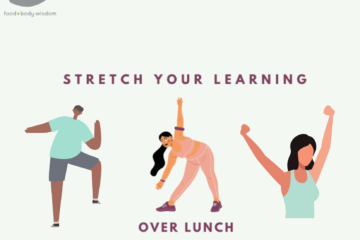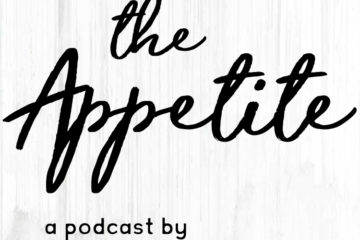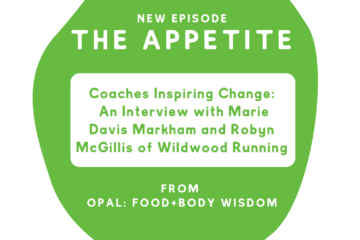[column width=”1/1″ last=”true” title=”” title_type=”single” animation=”none” implicit=”true”]
 I always look back with gratitude to the first time I was introduced to the Health At Every Size® message. I was a graduate student studying nutrition and health psychology and eager to help others. I was excited to say the least, that there was an alternative to the diet and weight loss interventions I so commonly knew. I longed for community and a chance to practice this model personally and professionally. After graduate school, I was fortunate to be hired at Opal and began to work within the HAES model with my clients and build community amongst the staff who were committed to living a HAES lifestyle. Then, my community of HAES-friendly practitioners grew abundantly after attending the five day Health at Every Size® Facilitator training last June. Therapists, dietitians, students, teachers, psychologists, psychiatrists, and nurse practitioners came together to learn how to facilitate and teach the HAES model to their clients. Even though I came to the training with a strong belief in the HAES model, I was surprised by how much personal growth I experienced. During the training, the presenters, Linda Bacon and Lucy Amphramor, taught the principles of Health At Every Size® by inviting participants to experience their bodies in new ways. In one activity, they asked us to divide into the room according to how we labeled our own body size. At first I was hesitant to speak up, and label myself as a woman with a larger body. However, I felt that I had a lot to say about the way my body has been judged in the past. I shared how I used to overcompensate for academics and personality, so that peers didn’t notice my body. I also shared how I was hesitant to enter the field of nutrition and dietetics simply because of the shape of my body. Other participants spoke of fear, shame, and embarrassment. Many voices echoed the message that we as women, regardless of size, want to be seen for something other than shape or size. At the end of the activity, we were all surprised how one label of size could cause such feelings of separateness, when an hour ago, that same room was filled with connection. This activity taught me that when my clients compare their size with other women, they too may feel isolated and shamed. I learned the importance of sharing my unique body story with others, so that I could teach my clients how to share theirs. It felt liberating to share how my body and pursuit of health has been affected by thin privilege. When we see a healthy body as only a thin body, we create shame and competition where there could be acceptance and celebration of diversity. During the training, I also learned that the beliefs we hold about bodies and health come from early messages and require experiential work to challenge them. I don’t believe it is enough to tell our clients to like their bodies more; we have to give them opportunities to experience themselves in new ways. The training strengthened and expanded my ability to have different conversations with my clients. We discuss acceptance, gratitude, grief, making amends with body parts, fear of body changes, and letting go of the idealized body. I encourage my clients to express their frustration and pain, in order to move forward towards health. I now understand the impact that a supportive community has on an individual’s ability to accept their body. I started co-leading Health At Every Size® support groups at Opal, and incorporate many of the experiential activities that I learned from the training. I get to be apart of other women coming together in community to begin the journey of body acceptance, in the same way I did when I signed up for the 5 day training. Many of the members in my Health at Every Size® support groups have had assumptions made about their health, based on what their body looks like. It is essential that we start recognizing how sizeism plays a large role in health. The HAES training taught me the necessary steps to understanding my clients’ stories before any other intervention can be done. It taught me the power that shame can have on someone’s decision or ambivalence to seek health behavior change. I choose to practice from a HAES model because I believe that all bodies deserve respect and equal care. I love that I can empower my clients to say no to the number on the scale. This model of health has changed the way I practice as a dietitian and therapist. After the training, I found myself having more conversations with women about their experiences with being labeled, stereotyped or shamed. I also had to look at my own biases against women who lived in smaller bodies than me. It eventually motivated me to start a monthly body talk group at Opal, where practitioners could discuss openly how their bodies and self-image are impacted by the work that they do. I highly recommend attending the five day Health At Every Size® training this upcoming June. It will be an experience for your own body acceptance as well as providing concrete interventions and techniques to use with clients. Most importantly, you can be a part of the growing community of HAES-friendly providers who promote this liberating message in both their personal and professional lives.
I always look back with gratitude to the first time I was introduced to the Health At Every Size® message. I was a graduate student studying nutrition and health psychology and eager to help others. I was excited to say the least, that there was an alternative to the diet and weight loss interventions I so commonly knew. I longed for community and a chance to practice this model personally and professionally. After graduate school, I was fortunate to be hired at Opal and began to work within the HAES model with my clients and build community amongst the staff who were committed to living a HAES lifestyle. Then, my community of HAES-friendly practitioners grew abundantly after attending the five day Health at Every Size® Facilitator training last June. Therapists, dietitians, students, teachers, psychologists, psychiatrists, and nurse practitioners came together to learn how to facilitate and teach the HAES model to their clients. Even though I came to the training with a strong belief in the HAES model, I was surprised by how much personal growth I experienced. During the training, the presenters, Linda Bacon and Lucy Amphramor, taught the principles of Health At Every Size® by inviting participants to experience their bodies in new ways. In one activity, they asked us to divide into the room according to how we labeled our own body size. At first I was hesitant to speak up, and label myself as a woman with a larger body. However, I felt that I had a lot to say about the way my body has been judged in the past. I shared how I used to overcompensate for academics and personality, so that peers didn’t notice my body. I also shared how I was hesitant to enter the field of nutrition and dietetics simply because of the shape of my body. Other participants spoke of fear, shame, and embarrassment. Many voices echoed the message that we as women, regardless of size, want to be seen for something other than shape or size. At the end of the activity, we were all surprised how one label of size could cause such feelings of separateness, when an hour ago, that same room was filled with connection. This activity taught me that when my clients compare their size with other women, they too may feel isolated and shamed. I learned the importance of sharing my unique body story with others, so that I could teach my clients how to share theirs. It felt liberating to share how my body and pursuit of health has been affected by thin privilege. When we see a healthy body as only a thin body, we create shame and competition where there could be acceptance and celebration of diversity. During the training, I also learned that the beliefs we hold about bodies and health come from early messages and require experiential work to challenge them. I don’t believe it is enough to tell our clients to like their bodies more; we have to give them opportunities to experience themselves in new ways. The training strengthened and expanded my ability to have different conversations with my clients. We discuss acceptance, gratitude, grief, making amends with body parts, fear of body changes, and letting go of the idealized body. I encourage my clients to express their frustration and pain, in order to move forward towards health. I now understand the impact that a supportive community has on an individual’s ability to accept their body. I started co-leading Health At Every Size® support groups at Opal, and incorporate many of the experiential activities that I learned from the training. I get to be apart of other women coming together in community to begin the journey of body acceptance, in the same way I did when I signed up for the 5 day training. Many of the members in my Health at Every Size® support groups have had assumptions made about their health, based on what their body looks like. It is essential that we start recognizing how sizeism plays a large role in health. The HAES training taught me the necessary steps to understanding my clients’ stories before any other intervention can be done. It taught me the power that shame can have on someone’s decision or ambivalence to seek health behavior change. I choose to practice from a HAES model because I believe that all bodies deserve respect and equal care. I love that I can empower my clients to say no to the number on the scale. This model of health has changed the way I practice as a dietitian and therapist. After the training, I found myself having more conversations with women about their experiences with being labeled, stereotyped or shamed. I also had to look at my own biases against women who lived in smaller bodies than me. It eventually motivated me to start a monthly body talk group at Opal, where practitioners could discuss openly how their bodies and self-image are impacted by the work that they do. I highly recommend attending the five day Health At Every Size® training this upcoming June. It will be an experience for your own body acceptance as well as providing concrete interventions and techniques to use with clients. Most importantly, you can be a part of the growing community of HAES-friendly providers who promote this liberating message in both their personal and professional lives.
[/column]


